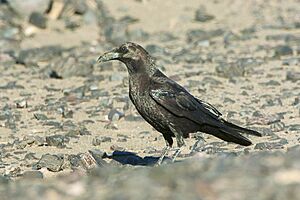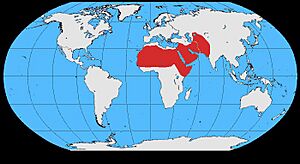Brown-necked raven facts for kids
Quick facts for kids Brown-necked raven |
|
|---|---|
 |
|
| Near Merzouga, Morocco | |
| Conservation status | |
| Scientific classification | |
| Genus: |
Corvus
|
| Species: |
ruficollis
|
 |
|
| Distribution map | |
| Synonyms | |
|
|
The brown-necked raven (Corvus ruficollis) is a large bird. It is about 52 to 56 centimeters long. This makes it bigger than a carrion crow. However, it is not as big as the common raven.
This raven looks a lot like the common raven. But its beak is not as big or deep. Its wings also look a bit more pointed. The bird's head and throat are a brownish-black color. This is how it got its name. The rest of its feathers are black. They can shine with purple, blue, or purplish-blue colors. Like other large ravens, it is one of the bigger raven types.
Sometimes, the feathers of this bird can fade quickly. They turn a brownish-black color. This happens even to the truly black feathers. So, the bird can look quite brown before it sheds its old feathers. Its feet, legs, and beak are all black. The dwarf raven used to be seen as a type of brown-necked raven. But now, scientists think it is more like the pied crow.
Contents
Where Do Brown-necked Ravens Live?
This bird lives in many places. You can find it across almost all of North Africa. It also lives as far south as Kenya. Its home also includes the Arabian Peninsula. You can find it up into the Greater Middle East and southern Iran.
What Kind of Places Do They Like?
Brown-necked ravens mostly live in desert areas. They often visit oases, which are green spots in the desert. They also like palm groves.
What Do Brown-necked Ravens Eat?
These ravens eat many different things. They eat dead animals, also known as carrion. They also hunt snakes and insects like locusts and other grasshoppers. If they live near the coast, they might eat fish that get stuck on the shore. They also steal grain from bags. Dates and other fruits are also part of their diet.
How Do They Behave?
Brown-necked ravens are usually quite brave. They are not easily scared if people leave them alone. But if people pay too much attention to them, they quickly become careful and shy. A study in Israel in 2009 showed something interesting. These ravens sometimes work together to hunt lizards. Some birds block the ways out, while others hunt the lizards.
How Do Brown-necked Ravens Build Nests?
Their nests are very similar to those of the common raven. They can build their nests in trees. They also build them on cliffs or inside old, ruined buildings. The dwarf raven seems to prefer building its nest in thorn trees.
Eggs and Young Birds
Female ravens usually lay 4 to 5 eggs. The parents keep the eggs warm for about 20 to 22 days. This is called incubation. The young birds usually leave the nest when they are about 37 or 38 days old. They can fly very well by the time they are 42 to 45 days old.
What Sounds Do Brown-necked Ravens Make?
The sounds they make are very much like the common raven's. They mostly make croaking sounds. However, their croaks are a bit higher in pitch. They also make a harsh "karr-karr-karr" sound. When they are flying, they will often say "kuerk-kuerk".
Can They Copy Sounds?
Like all birds in the crow family (called corvids), the brown-necked raven can copy sounds. This is called vocal mimicry. Most of the time, this behavior is seen in ravens that live in zoos or are kept as pets. But sometimes, it has been heard in wild ravens too.
Gallery





